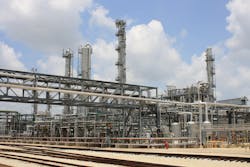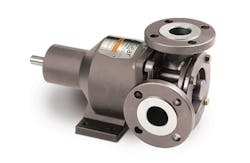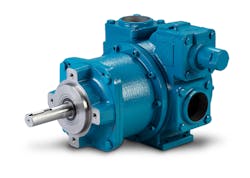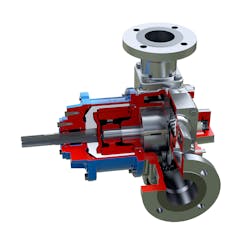The advantages of magnetic-drive PD pumps in chemical processing
Chemical processing facilities use a wide array of flowing substances that must be processed, stored and transferred during manufacturing activities. The technology tasked with facilitating this liquid movement is the industrial pump. As befits what has grown into a very large global industry, a number of competing technologies are constantly positioning themselves to grab the attention – and capital-investment dollars – of the world’s chemical processors.
The oldest of these battles divided the camps into those that favored centrifugal pump technology, which uses velocity, momentum and kinetic energy to transfer the liquid – but only if the pump is operating at or near its Best Efficiency Point (BEP) – and those with an affinity for positive displacement (PD) pump technologies, which capture a fixed volume of liquid and transfer it “like clockwork.” These distinctions have led some to call centrifugal pumps “emotional,” since changes to their liquid and system environment directly influence their operational capabilities, while PD pumps are seen as more “stoic,” with the pump steadfastly achieving peak efficiency at all times, no matter the changes in operating environment.
In recent years, however, the discussion has begun to revolve around another design distinction: is the best pump – be it PD or centrifugal – for chemical processing applications sealed or seal-less? This article will answer that question while illustrating that seal-less PD sliding vane and internal gear pump technologies can ultimately be the best choice within the realm of the PD pump universe.
(Un)sealing the deal
It is simple, really: sealed pumps use dynamic seals to keep the liquid contained, while seal-less pumps do not require dynamic seals to contain the liquid. Sealed pumps can accommodate a constant bleed of trace fluid across the seal faces (even in double seals), whereas seal-less pumps offer true leak-free operation. Although sealed pumps remain more common, seals are viewed as the weakest link in a pump’s operational chain, with analysis of pumping operations indicating that upwards of 80% of all pump failures originate at the seal. A quick tour through any chemical processing facility will support this hypothesis: look for wet baseplates and empty baseplates. Both indicate reduced uptime related to a failure in a sealing device.
Now, this does not mean that all of these failures are solely the seal’s fault. In fact, there are many operational occurrences – pulsation, vibration, shaft deflection, dry run, viscosity, temperature and pressure changes, and liquid crystallization, to name just a few – that can cause the seal to leak or fail, either of which will put the pump out of service. Regardless, a compelling case is created for seal-less pumps since using this pumping technology would theoretically remove eight of every 10 seal-related downtime occurrences, eight of the 10 times ancillary costs for maintenance and repair are incurred, eight of the 10 times you need a maintenance staff or, to sum it all up, eight of the 10 headaches that are inherent in operating a pump.
So, if we can agree that there are compelling reasons to consider incorporating seal-less pumps in a chemical processing operation, the next question becomes: “Which type of seal-less pump?” Which brings the discussion back to the centrifugal or PD pump conundrum.
There has been recent growth in next-generation seal-less designs that feature a magnetic-drive coupling that is used to transmit torque to the pump. In these configurations, a magnetic coupling connects the driving shaft to the driven shaft without use of a dynamic seal to keep the pumped liquids contained.
Admittedly, mag-drive seal-less pumps typically have a higher purchase price than basic sealed pumps, but as the seals and accompanying seal-support systems get more complicated – and remain more prone to failure – they get more expensive. For example, a triple-lip seal can cost $3,000, and if you are repairing or replacing it every 12-to-18 months that cost will add up, along with the added expense of any maintenance or repair calls. Or, for double mechanical seals that require seal-support systems, the seal-support system adds $4,000 to $8,000 itself in purchase cost, plus associated costs for monitoring equipment.
Financial considerations aside, mag-drive seal-less PD pumps outperform their seal-less centrifugal cousins by offering new functionality that is not possible with centrifugal pumps. First, seal-less PD pumps are self-priming and have good suction-lift capabilities while mag-drive centrifugal pumps, just like sealed centrifugal pumps, rely on an integral reservoir that must be pre-filled before it is turned on, meaning that they technically are not self-priming pumps, but pre-primed pumps. Second, seal-less PD pumps allow for bi-directional operation. Simply rotate the pump forward or backwards to achieve line stripping in either direction, saving on fluid waste and improved safety in your facility. Third, seal-less PD pumps are not sensitive to changes in operating environment (liquid or system conditions), unlike centrifugal pumps, which must be tuned to a single BEP or they will react negatively to changes in their environment. Finally, seal-less PD pumps can dry run for extended periods, process suspended solids and accommodate zero-NPSHa systems, whereas centrifugal pumps struggle in each of these areas.
Assessing the PD options
With seal-less centrifugal pumps removed from the equation, it is time to fully consider the seal-less PD options. The most popular in chemical processing applications have proven to be air-operated double-diaphragm (AODD) and peristaltic (hose) pumps. The standout feature of both of these technologies is their ability to pull a perfect vacuum, which thereby enables them to self-prime and achieve good suction lift.
Specifically, AODD pumps are a first-choice seal-less technology for utilitarian pumping applications for a number of reasons: they are inexpensive, very flexible and easy to operate (all you need is an air hose and suction pipe). There are also some shortcomings: their flow and pressure capacities are narrower than some other PD pump technologies, they create pulsation in the liquid path and, because air is expensive, they can be costly to operate, especially when used in continuous-duty applications.
Peristaltic pumps are ideal for handling thick slurries and liquids with large solids and deliver flow-rate consistency despite changes in pressure, but their flow-rate range is limited and pulsating flow can occur, which will make it difficult to dial in a specific flow rate. From a footprint standpoint, peristaltic pumps are larger than many other technologies, which means they require more operating space. Also, if/when the pump’s hoses fail, a catastrophic leak can occur, and hose degradation during operation can compromise the integrity of more sensitive liquids.
On the other hand, two of the lesser-known seal-less PD pump technologies that feature a mag-drive design are sliding vane and internal gear. The basic advantages of these mag-drive pumps are that they are electrically driven, so there is no need for compressed air; they have a wide and consistent flow-rate range; they create no pulsation in the liquid; they operate well at higher temperatures; they are immune to changes in liquid viscosity or pressure; and they are truly self-priming, meaning they can prime while being bone dry, right out of the box.
Let's take a closer look at the specific advantages of each technology:
Sliding vane
Sliding vane technology self-compensates for wear, sustaining new performance throughout the pump’s operational life. Vane pumps uniquely allow a wide viscosity and pressure range, and are well suited for challenging applications like those with suspended solids, varying system pressure, zero NPSHa, liquid/vapor mix and regular dry-run operation. The latest advancement in sliding vane pumps is a seal-less magnetic-drive technology that offers a first-in-class combination of functionality, reliability and flexibility.
- Reliability: The new mag-drive sliding vane technology allows for extended and expected dry-run, suspended-solids levels of up to 20%, zero-NPSHr performance that is ideal for challenging pump inlet conditions — including with liquids featuring up to 20% vapor or air content — and provides peace-of-mind uptime without use of nuisance current-monitoring systems.
- Functionality: The new mag-drive sliding vane technology can achieve suction lift of more than 25 feet without need to pre-prime the system, provides bi-directional flow, and can line strip to reduce product waste during or after production runs.
- Flexibility: The new mag-drive sliding vane technology provides a wide operating range that is immune to changing fluid and system conditions. Further, the flow and pressure range of 15 unique centrifugal frame sizes is achieved with just two vane pump sizes, optimizing asset flexibility.
Internal gear
Today’s advanced magnetically coupled internal gear pumps have a simple design that features only seven main components. The heart of the design is a bearing-to-bearing support system that eliminates leaks. The pump’s short spindle also overcomes the challenges that are inherent in pump technologies with longer spindles, namely the impact of overhung loads that can lead to premature wear and failure. Also, unlike centrifugal pumps that rely on cantilevered bearings, internal gear pumps have symmetrical shaft support, which eliminates shaft deflection during operation, resulting in less maintenance and downtime.
Another standout feature of some magnetically coupled gear pumps is a single-liquid-chamber design that improves liquid circulation through the coupling area. This results in longer magnet life, lower operating temperatures and more efficient cleaning and flushing processes. By comparison, some gear pump designs feature a long, tortuous flow path, which can raise the temperature of the liquid as it is being transferred to levels that can compromise magnet life.
So, now the decision involves a choice between PD seal-less mag-drive sliding vane and seal-less mag-drive internal gear pumps. This chart can help the operators of chemical-processing facilities decide on the best choice for their specific applications from two top-end technologies:
Conclusion
Recent advancements in seal-less sliding vane and internal gear pump technology provide new functionality, reliability and flexibility for chemical processing facilities. These innovative new pump designs are leak-free and help eliminate pervasive pain points of legacy technology that has been used in chemical processing applications. Now, chemical processors can leverage new options that combines leak-free, seal-less performance with the inherent operational advantages that positive displacement sliding and gear pumps possess. These new technologies stand ready to be deployed in the most critical chemical-processing operations.
Geoff VanLeeuwen, P.E., is the director of products & applications for Blackmer and PSG. He can be reached at [email protected].
Michael Coburn is the product manager for EnviroGear and PSG. He can be reached at [email protected].
Blackmer
About the Author
Michael Coburn
Product Manager for EnviroGear and PSG
Michael Coburn is the director of engineering and product management for the Blackmer brand at PSG Grand Rapids. He can be reached at [email protected].




